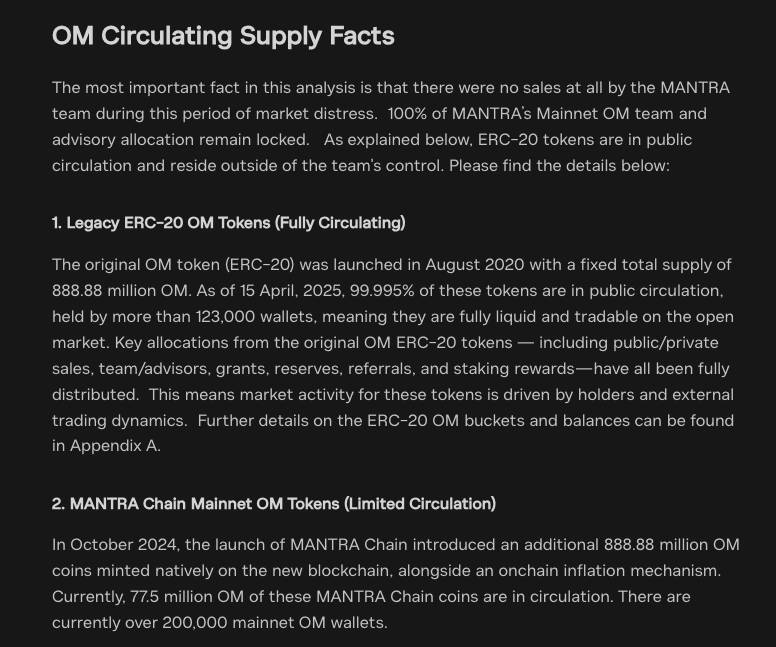The decentralized finance (DeFi) landscape is reeling from a significant incident involving the Mantra platform, which faced a staggering 92% flash crash of its OM token on April 13. In an official statement released shortly after the event, titled “Statement of Events: 13 April 2025,” the Mantra team aimed to address some of the confusion surrounding this dramatic market movement. They clarified that the crash did not stem from any token sales initiated by the project itself, as the team vows to maintain operations and continue investigating the incident.
In a recent announcement, the Mantra team underscored the complexities surrounding the two distinct types of OM tokens: the Ethereum-based (ERC-20) version and the Mantra mainnet version. The crash predominantly impacted the ERC-20 OM tokens, which make up the vast majority of the liquid market. Originally launched in August 2020 with a capped supply of 888.8 million tokens, around 99.9% of these ERC-20 tokens were already in circulation by April 15, further complicating the situation.
Additionally, the statement highlighted notable differences in OM spot prices across major exchanges, namely OKX and Binance, which began diverging just before the crash. The team pointed out that insights from their exchange partners could shed light on the trading dynamics leading up to this troubling event. As part of their response strategy, the Mantra team is reportedly working on a support plan for the OM token that includes a token buyback and supply burn, although a specific timeline remains unannounced.
“We invite our centralized exchanges partners to collaborate on providing more clarity on trading activities during this time,”
With prominent figures in the industry chiming in—OKX CEO Star Xu labeled the situation a “big scandal”—the aftermath of this flash crash has certainly placed Mantra under scrutiny. Eager to regain community trust, CEO John Mullin noted that Binance has emerged as the largest holder of the OM token, as indicated by Etherscan records. As the investigation continues, the DeFi community remains watchful for updates on Mantra’s efforts to stabilize the situation and restore confidence.
Key Points from Mantra’s Official Statement on OM Token Flash Crash
On April 13, the decentralized finance platform Mantra experienced a significant flash crash of its OM token. The following key points highlight the critical aspects of the event and its implications:
- 92% Flash Crash: The OM token suffered a drastic decline on April 13, signaling severe volatility in the market.
- No Token Sales: Mantra clarified that the incident did not involve any sales by the project itself, suggesting external factors were at play.
- ERC-20 Token Dominance: The crash predominantly involved ERC-20 OM tokens, which represent virtually the entire liquid market, as 99.9% of the fixed supply was in circulation.
- Discrepancy in Spot Prices: A significant divergence in OM token prices on exchanges like OKX and Binance was noted, occurring shortly before the crash.
- Investigation Underway: The Mantra team is actively investigating the events surrounding the crash and invites centralized exchanges to collaborate for clarity.
- Support Plan for OM: A forthcoming support plan includes a token buyback and supply burn, aimed at stabilizing the OM token’s value, though no specific timeline was provided.
- Community Trust: The CEO has mentioned plans to burn team’s tokens to regain trust from the community following the incident.
“We invite our centralized exchanges partners to collaborate on providing more clarity on trading activities during this time.” – Mantra Team
These points reflect critical considerations for current and potential investors in the OM token. The lack of internal token manipulation could provide some reassurance, but the need for clarity around external trading activities is crucial. Investors should remain cautious given the ongoing volatility and the absence of a clear timeline for remedial actions.
Mantra’s DeFi Flash Crash: Opportunities and Challenges in a Turbulent Market
The decentralized finance (DeFi) landscape is not without its ups and downs, as evidenced by the recent tumultuous events surrounding the Mantra platform. Mantra’s 92% flash crash of its OM token has drawn significant attention, raising questions about the integrity and stability of DeFi projects. This is not the first time a DeFi platform has faced a crisis; however, the way Mantra has chosen to address the situation offers some insights into its competitive advantages and disadvantages against similar news in the sector.
One of the key advantages of Mantra’s response is its commitment to transparency. The official statement not only clarified that the crash did not stem from token sales by the project but also emphasized that the team is actively investigating. In a market where trust is paramount, this proactive approach can help build confidence among investors. In contrast, other platforms that have issued vague or defensive releases during crises have often faced heightened scrutiny and skepticism.
However, the lack of substantial new information in their communications could be a drawback. Mantra’s investigation, while necessary, may leave stakeholders dissatisfied if the results do not yield actionable insights or if they are delayed. Additionally, the involvement of major exchanges like OKX and Binance, which have made critical remarks about the crash, muddies the waters. This external pressure could weaken Mantra’s market position, especially as competitors with similar offerings may exploit the situation to gain the trust of a shaken investor base.
For investors closely tied to Mantra, the fallout from the crash may present a dual-edged sword. On one hand, the upcoming support plan, which includes a token buyback and supply burn, could potentially enhance the remaining supply’s value. On the other hand, for those who suffered losses during the crash, the trust deficit might lead them to seek refuge in more stable or reputable DeFi platforms ahead of future investments.
Moreover, competitive platforms can benefit from Mantra’s misfortunes. They could leverage this incident in their marketing strategies, portraying themselves as safer or more reliable alternatives for potential investors. Conversely, the entire DeFi sector takes a hit whenever such significant market events occur, as broader investor apprehension can slow down new investments across all platforms.
As the Mantra team continues to navigate this challenging landscape, how they manage stakeholder expectations and respond to emerging details will significantly influence their rehabilitation efforts. Ultimately, the direction they take could either restore faith in their platform or exacerbate skepticism towards the DeFi industry as a whole.

















